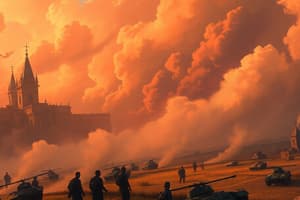Podcast
Questions and Answers
What is the primary motivation for humans to study the past?
What is the primary motivation for humans to study the past?
- To replicate historical lifestyles in modern times.
- To escape from current problems by focusing on the past.
- To predict future events accurately.
- To gain a better understanding of the present. (correct)
Why is the understanding of the past always linked to the present?
Why is the understanding of the past always linked to the present?
- The past is more relevant than the present for decision-making.
- Knowledge of the past helps us understand our current circumstances. (correct)
- Studying the past is an escape from dealing with current issues.
- Historical events directly dictate current affairs.
What should we do with connections between past and present societies?
What should we do with connections between past and present societies?
- Avoid the connections using different methods.
- Understand the connections and their significance. (correct)
- Determine which connections are more important.
- Overlook the connections.
What is a key element that precedes knowledge?
What is a key element that precedes knowledge?
What do values provide for people, and how do they evolve?
What do values provide for people, and how do they evolve?
Why is it important to avoid simply applying our own present-day ideas to understand how people organized themselves in earlier communities?
Why is it important to avoid simply applying our own present-day ideas to understand how people organized themselves in earlier communities?
Which factor primarily contributed to the transition from nomadic to settled life during the Neolithic Revolution?
Which factor primarily contributed to the transition from nomadic to settled life during the Neolithic Revolution?
What was the significance of the shift to a sedentary lifestyle during the Neolithic Revolution?
What was the significance of the shift to a sedentary lifestyle during the Neolithic Revolution?
What development marked the end of the prehistoric period and the beginning of the early historic period?
What development marked the end of the prehistoric period and the beginning of the early historic period?
How did the ability to store grains impact human settlements?
How did the ability to store grains impact human settlements?
How did the development of pottery contribute to the advancement of settled communities?
How did the development of pottery contribute to the advancement of settled communities?
What conclusion can be drawn from the evidence that some groups abandoned agriculture after initially adopting it?
What conclusion can be drawn from the evidence that some groups abandoned agriculture after initially adopting it?
What critical factor allowed for a greater number of people to be sustained in a single area, compared to earlier times?
What critical factor allowed for a greater number of people to be sustained in a single area, compared to earlier times?
What social transformation did the development of agriculture primarily lead to?
What social transformation did the development of agriculture primarily lead to?
Which skill advanced due to an agricultural lifestyle?
Which skill advanced due to an agricultural lifestyle?
What can analysis of skeletal remains reveal about prehistoric people?
What can analysis of skeletal remains reveal about prehistoric people?
Why did the archaeologist Ferdinand Keller name the builders of the settlement constructions near the Zurichsee ‘Pile builders’?
Why did the archaeologist Ferdinand Keller name the builders of the settlement constructions near the Zurichsee ‘Pile builders’?
What evidence suggests that trade and cultural exchange occurred in Neolithic Europe?
What evidence suggests that trade and cultural exchange occurred in Neolithic Europe?
What does the text mean by calling the shift towards agricultural life a ‘Neolithic Revolution’?
What does the text mean by calling the shift towards agricultural life a ‘Neolithic Revolution’?
In what way did farming influence the size of communities?
In what way did farming influence the size of communities?
What made archaeologists think that neolithic settlements near Lake Constance were more complex than first believed?
What made archaeologists think that neolithic settlements near Lake Constance were more complex than first believed?
What feature is most characteristic of advanced civilizations?
What feature is most characteristic of advanced civilizations?
What was the main reason why Egyptian hieroglyphs were created?
What was the main reason why Egyptian hieroglyphs were created?
What evidence of Egyptian society can still be seen today?
What evidence of Egyptian society can still be seen today?
What was one of the purposes of the Great Wall of China?
What was one of the purposes of the Great Wall of China?
Flashcards
Ur- und Frühgeschichte
Ur- und Frühgeschichte
The period covering from the earliest traces of humanity to the beginning of written records, ending approximately 800 v. Chr.
Steinwerkzeuge
Steinwerkzeuge
Objects made of stone used by early humans as tools like hand axes and basic cutting tools.
Homo erectus
Homo erectus
An extinct species, considered an ancestor to modern humans, known to have migrated out of Africa.
Homo neanderthalensis
Homo neanderthalensis
Signup and view all the flashcards
Homo sapiens
Homo sapiens
Signup and view all the flashcards
Neolithische Revolution
Neolithische Revolution
Signup and view all the flashcards
Textilien
Textilien
Signup and view all the flashcards
Erz
Erz
Signup and view all the flashcards
Hochkulturen
Hochkulturen
Signup and view all the flashcards
Ägyptische Hieroglyphen
Ägyptische Hieroglyphen
Signup and view all the flashcards
Dynastie
Dynastie
Signup and view all the flashcards
Study Notes
- The text is a German history and politics textbook for secondary school students, titled "Societies in Transition."
Content Overview
- The text covers history from prehistoric times to the present and future.
- It explores the early history of humanity and the first advanced civilizations (2.5 million-800 BC).
- It discusses antiquity (800 BC – 500 AD) and the Middle Ages (500-1500).
- The textbook covers the early modern period (1450-1800) and Europe's global role during that time.
- It also addresses conflict and exchange in early modern Europe (1500-1800).
- The "long" 19th century (1750-1900) looks at the beginning of modernity and industrialization.
- Nationalism and imperialism (1800-1914) are examined.
- The rise of mass society (1830-1930) is explored.
- The "short" 20th century covers World War I and the interwar period (1914-1933).
- Focus is given to National Socialism and World War II (1933-1945).
- Discussions on social change in the post-war period (1945-1989) takes place, and covers the Cold War era (1945-1989).
- It touches upon contemporary and future topics (1945-present).
- Focus on Switzerland's democracy in Europe and the contemporary world.
- It prompts students to consider the meaning of historical thinking.
Examining the Past
- Engaging with the past involves traveling to a foreign land by asking questions to understand the present better.
- Knowledge of the past is related to the present.
- Exploring the past means exploring an unknown world out of curiosity.
- Instead of seeing learning resources as intimidating, it needs to be approached by formulating exploratory questions.
- Questions about personal experiences or current events can be starting points.
Analyzing Historical Information
- Everything in the book is in some way related to the present.
- Connections between past and present societies are formed by asking the right questions.
- Students can use appropriate methods to learn and understand these connections.
- History isn't limited to major events but includes everyday aspects of life.
- Personal experiences, like how relatives interacted without modern technology, are relevant.
Discovering Relics of the Past
- The past leaves traces in memories, values, objects, buildings, and the internet.
- A time machine trip 50 years into the past would feel foreign but still connect to the present.
- People can share stories about the past to get a clearer vision of what life was like.
- The concept of a society refers to a large group of people organizing their lives together.
- Methods refer to how knowledge is acquired in a particular field.
- Values provide orientation but change over time.
History in Prehistoric Times
- Prehistory spans a long time, ending with the beginning of Antiquity around 800 BC
- Early humans lived by hunting, gathering fruit, and using tools.
- Humans established settlements, farmed, and lived in communities before discovering writing which then became known as prehistoric times.
Early Humans
- Early humans made Stone tools were the first objects made by humans.
- Stone tools lasted, and were utilized in different ways.
- The Stone Age is called the Stone Age.
The Development of Skills and Habits
- Two million years ago, the earliest stone tools can be traced back to Africa.
- Advanced tools were developed in the Stone Age.
- Art objects were made.
- Carvings from bones, cave wall paintings, etc., show how skills evolved.
Shifting Lifestyles of People
- Homo erectus, an early form of humans, evolved and expanded out of Africa.
- The Homo sapiens evolved in today's Europe about 200,000 years ago.
- Homo sapiens colonized the planet 100,000 years ago and are the origin of modern humans.
Neolithic Revolution
- About 10,000 years ago, at various locations on Earth, a new way of life unfolded.
- People grew plants and kept animals.
- A more permanent lifestyle of settlement was developed.
- A "Neolithic Revolution" refers to this evolution.
Traces of Early Civilizations
- The oldest civilizations end with early written sources.
Discovering Info About the Stone Age
- Brigitte Röder, in an interview, explains how to learn about the Stone Age without texts.
- Natural scientific studies can identify a person's gender, general health, and even mobility.
- People were more mobile than previously thought.
The Analysis of Relics
- Items that have stood the test of time in daily routines, in the form of ceramic vessels or tools that were identified by looking at civilizations and finding new methods for societies to use.
Social Structure
- Prehistoric civilizations had vastly different socio-economic configurations by examining the different artifacts.
Ancient Life
- People may follow certain religious or political obligations but, The answer may never materialize concerning how social structures actually functioned.
Ancient Child Activities
- We may have erroneous or inexact conclusions on prehistory based on how we now interpret their world vs our own.
A Revolution
- Cultivation of grains and animal husbandry was the new trend for humanity.
- Grains provide energy for the civilization.
The Era of New Settlement
- People built their houses and began to settle down and develop communities.
Stone Age Diet
- Some groups gave up their hunting and collecting of plants.
The Origins of Farming
- Farming developed food in a new way.
- Southeastern Anatolia (Turkey's Southeast and Syria's North and Iraq) and Europe became the grain producing regions.
The Early Animal Herders
- Hunters would catch wild animals and began to tamed them in large groups to protect resources.
Long-Term Revolution
- Neolithic Revolution occurred very slowly for 1000's of years and evolved in South Anatolia for their way of life.
Reasons for Revolution
- Climate change may have made grains, sheep, and goats the most important to herd for communities.
Neolithic Progress
- Skeletons reveal evidence of the civilization suffering from disease and lack of nutrition due to crop failures.
Civilizations and Revolution
- Civilizations abandoned farming to hunting as a new way of life.
Studying That Suits You
Use AI to generate personalized quizzes and flashcards to suit your learning preferences.
Related Documents
Description
A German history textbook for secondary school students, titled Societies in Transition, encompassing history and politics from prehistoric times to the present. It explores early civilizations, antiquity, the Middle Ages, the early modern period, and Europe's global role. It also addresses modern topics like nationalism, imperialism and the world wars.




